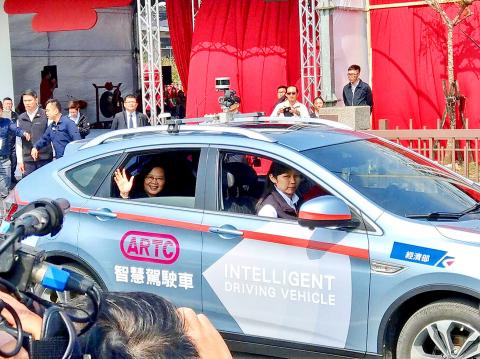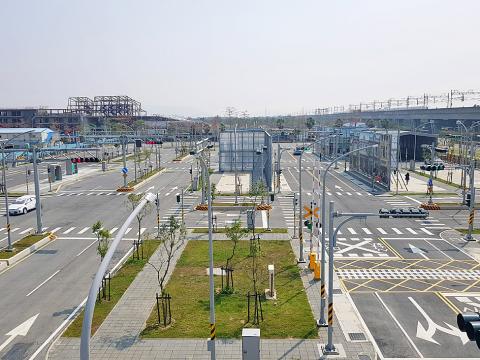President Tsai Ing-wen (蔡英文) yesterday opened the nation’s first closed testing ground for self-driving cars, the Taiwan CAR (connected, autonomous and road-test) Lab in Tainan.
“Autonomous car technology is an opportunity that Taiwanese industries cannot miss,” and it is expected to help bring local vehicle component manufacturing and the entire technological industry to new heights, she said.
Following the enactment of the Act for Uncrewed Vehicle Technology Innovations and Experiments (無人載具科技創新實驗條例) last year, other traffic regulations, and financial and insurance systems are being planned, Tsai said.

Photo: Chien Hui-ju, Taipei Times
Tsai and former premier William Lai (賴清德) — a former Tainan mayor — toured the lab site in a car made by the Automotive Research and Testing Center, one of three at the facility, with the vehicle easily moving around a car-shaped barrier.
The Taiwan CAR Lab covers 1.75 hectares in the Salun Smart Green Energy Science City compound and features 13 simulated traffic scenarios, the National Applied Research Laboratories (NARL) said.
The other vehicles at the lab were made by Acer Inc (宏碁) and National Cheng Kung University faculty, and they can achieve level 4 automation — high automation without human presence in specific conditions, NARL Planning and Promotion Office associate researcher Chang Lung-yao (張龍耀) said.

Photo: Chien Hui-ju, Taipei Times
However, crew members are required to be on standby inside the vehicles at this stage, Chang said.
Building the Taiwan CAR Lab cost about NT$250 million (US$8.12 million at the current exchange rate) and took nine months, he said, adding that test dummies, fake motor scooters and a rain simulation would be added later.
Automated cars have to undergo testing within a closed area before they can be tested on open roads, and step-by-step progress is more suitable to Taiwan given its limited market scope, Minister of Science and Technology Chen Liang-gee (陳良基) said.
The ministry is collaborating with the European Chamber of Commerce Taiwan to ensure that the safety standards for local autonomous cars match global criteria, Chen said.
Driverless navigation is a cross-disciplinary industry that is open to students in all university departments, especially as some researchers are studying passenger behavior in such vehicles, he added.
The Office of Science and Technology is consulting with the six special municipalities about using larger autonomous buses for public transport in designated areas, which might happen next year, office Executive Secretary Tsai Zse-hong (蔡志宏) said.
A group of Cheng Kung students attended yesterday’s opening ceremony to see a model car they helped developed with Juang Jyh-ching (莊智清), a professor of electrical engineering, and other faculty members.
Integrating data collected from the vehicle’s sensing, positioning and controlling systems was the most challenging part of developing it, and their team would continue to work on improving related technology for future road testing in populated areas, the students said.

LIMITS: While China increases military pressure on Taiwan and expands its use of cognitive warfare, it is unwilling to target tech supply chains, the report said US and Taiwan military officials have warned that the Chinese People’s Liberation Army (PLA) could implement a blockade within “a matter of hours” and need only “minimal conversion time” prior to an attack on Taiwan, a report released on Tuesday by the US Senate’s China Economic and Security Review Commission said. “While there is no indication that China is planning an imminent attack, the United States and its allies and partners can no longer assume that a Taiwan contingency is a distant possibility for which they would have ample time to prepare,” it said. The commission made the comments in its annual

DETERMINATION: Beijing’s actions toward Tokyo have drawn international attention, but would likely bolster regional coordination and defense networks, the report said Japanese Prime Minister Sanae Takaichi’s administration is likely to prioritize security reforms and deterrence in the face of recent “hybrid” threats from China, the National Security Bureau (NSB) said. The bureau made the assessment in a written report to the Legislative Yuan ahead of an oral report and questions-and-answers session at the legislature’s Foreign Affairs and National Defense Committee tomorrow. The key points of Japan’s security reforms would be to reinforce security cooperation with the US, including enhancing defense deployment in the first island chain, pushing forward the integrated command and operations of the Japan Self-Defense Forces and US Forces Japan, as

‘TROUBLEMAKER’: Most countries believe that it is China — rather than Taiwan — that is undermining regional peace and stability with its coercive tactics, the president said China should restrain itself and refrain from being a troublemaker that sabotages peace and stability in the Indo-Pacific region, President William Lai (賴清德) said yesterday. Lai made the remarks after China Coast Guard vessels sailed into disputed waters off the Senkaku Islands — known as the Diaoyutai Islands (釣魚台) in Taiwan — following a remark Japanese Prime Minister Sanae Takaichi made regarding Taiwan. Takaichi during a parliamentary session on Nov. 7 said that a “Taiwan contingency” involving a Chinese naval blockade could qualify as a “survival-threatening situation” for Japan, and trigger Tokyo’s deployment of its military for defense. Asked about the escalating tensions

The Ministry of Economic Affairs said it plans to revise the export control list for strategic high-tech products by adding 18 items under three categories — advanced 3D printing equipment, advanced semiconductor equipment and quantum computers — which would require local manufacturers to obtain licenses for their export. The ministry’s announcement yesterday came as the International Trade Administration issued a 60-day preview period for planned revisions to the Export Control List for Dual Use Items and Technology (軍商兩用貨品及技術出口管制清單) and the Common Military List (一般軍用貨品清單), which fall under regulations governing export destinations for strategic high-tech commodities and specific strategic high-tech commodities. The